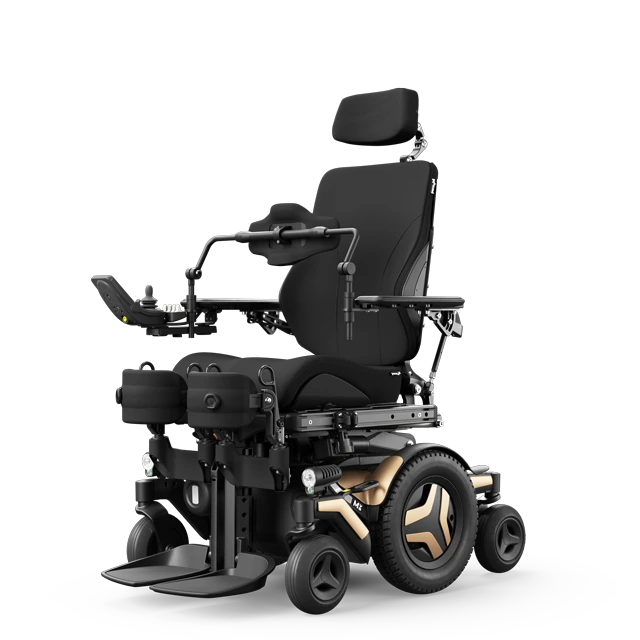What happens in a power wheelchair assessment?
Posted on 7 July 2020 By Aaron Stretton

In This Article
A power wheelchair, or powerchair, is a high-spec electric wheelchair designed for people with disabilities. Each wheelchair is tailored to…
A power wheelchair, or powerchair, is a high-spec electric wheelchair designed for people with disabilities. Each wheelchair is tailored to the individual user’s needs.
The goal is to use technology to provide users with the best possible compensation for their disabilities. Over the years, we’ve assessed and specified hundreds of power wheelchairs which have helped people to live more independently and maximise their quality of life.
Looking for a new powerchair for a client, family member, or yourself? This step-by-step guide covers everything you can expect from a power wheelchair assessment:
1) Initial Consultation
When you first get in touch with Innova, you will be assigned a specialist adviser. They will look after each stage of the assessment and be your personal point of contact if you have any questions.
First things first, they will talk through the user’s needs and get essential details, including:
- Height
- Weight
- Age
- What kind of seating they currently use
- Which conditions they have
- What restrictions or problems they are currently facing
At this stage, we might need to speak to the family, case manager, OTs and other healthcare professionals, other carers, and the client themselves.
Who uses power wheelchairs?
Powerchairs are suitable for people with a wide range of conditions because they are highly customisable.
However, we find our range of powerchairs is especially well-suited to individuals with:
- Acquired Brain Injury
- Spinal Injury
- Cerebral Palsy
- Amputation
2) Setting Goals & Specifications
After this consultation, a face-to-face meeting will be booked to go over goals and determine what the client wants to achieve in the future.
Goals for power wheelchair users
Common goals include:
- Increased independence e.g. driving the wheelchair themselves.
- Improved posture e.g. for comfort or to avoid worsening any postural abnormalities.
- Improved communication e.g. being able to adjust their chair to see eye-to-eye with someone they are talking to.
These goals help determine the required features for the power chair.
For example, if the user wants to be able to stand to talk to people or reach countertops then their powerchair must include a vertical stand function.
If they want to drive the wheelchair themselves, we will review their abilities to decide whether hand, head, switch-button, or another type of control would be best.
Specifying sizing
During this meeting, your adviser will also take some measurements. This allows us to create a detailed specification including seat sizing.
These measurements will include:
1) Depth leg length
2) Height leg length
3) Hip width
4) Height to top of shoulders
5) Height to top of head
6) Distance from elbow to hand
8) Chest width
9) Chest depth
10) Distance between armrests
Using all this information, we can put together a full draft prescription for the power wheelchair.
3) Trying a Demo Model
From this prescription, we will build a demonstrator model of the recommended powerchair.
There will be a second assessment on-site where the user can try the demonstrator chair. Adjustments can be made to make sure the wheelchair meets their specific user requirements.
Sometimes, a second visit may be required. This is helpful when there are more complicated seating or control requirements to review.
If needed, we can even arrange a loan period. This allows the user to really test the wheelchair in their own environment to ensure all specification details are just right before ordering their own powerchair.
4) Quotes & Funding
Once the specification is finalised, we will provide a full quote.
When needed, we will liaise with case managers, solicitors, occupational therapists etc. to get funding approved.
Then, we order the wheelchair! All orders arrive at our warehouse. Our team of specialists then get to work fitting accessories and components to customise the chair to the correct specification and size.
5) Delivery
When the powerchair is fully built to specification, it’s time to arrange delivery.
We book in delivery with the client’s key support group. So, that might include family, their occupational therapist… essentially everyone who was involved in finding the right wheelchair.
There will be a handover where the adviser does some final adjustments and set up on-site. We will also provide some training on operating and maintaining the powerchair.
For highly specialised wheelchairs, this handover can be phased over a few sessions.
6) Review
After delivery, the client can really start enjoying their powerchair and try it out in different scenarios and settings!
If there are any issues or concerns, contact your adviser. We always stay in touch with our powerchair clients — especially in the first 6 months.
We can arrange further visits to refine any detailed requirements. If new goals or challenges come up after the initial handover, we can also adjust the chair to support these.
The top priority is making sure the powerchair meets the user’s needs and continues to enhance their quality of life.
Enquire about a power wheelchair
Finding the right powerchair for each client is what we’re all about. We’ve seen the positive impact the right support and aids have on everyday life. So, we’re passionate about connecting as many people as possible with the right chair for them.
For advice on the different options available, or to start a power wheelchair assessment, get in touch:
Speak to The Experts
Need assistance with product enquiries, general inquiries, or product support? Our Phonelines are open 9am - 5pm Monday to Friday
0113 519 0319
Or, fill out the form for a call back.
